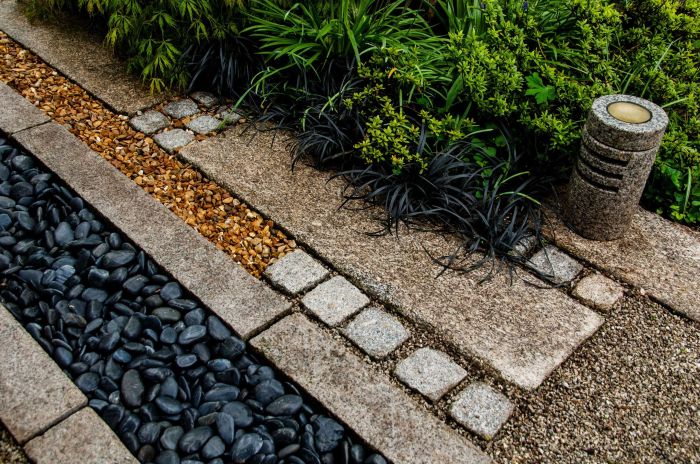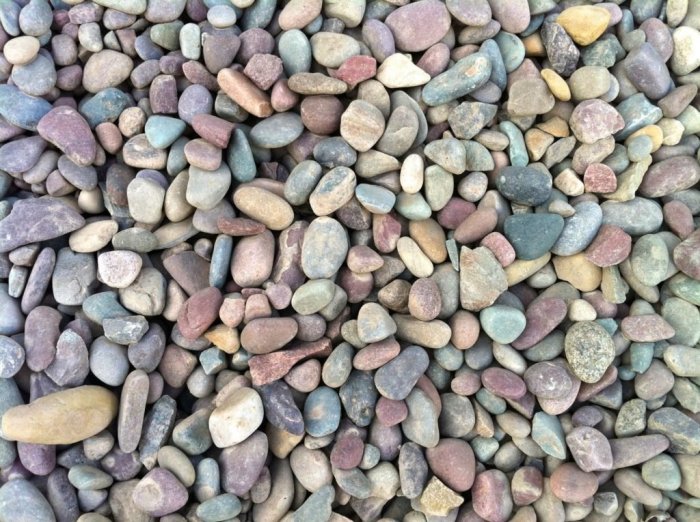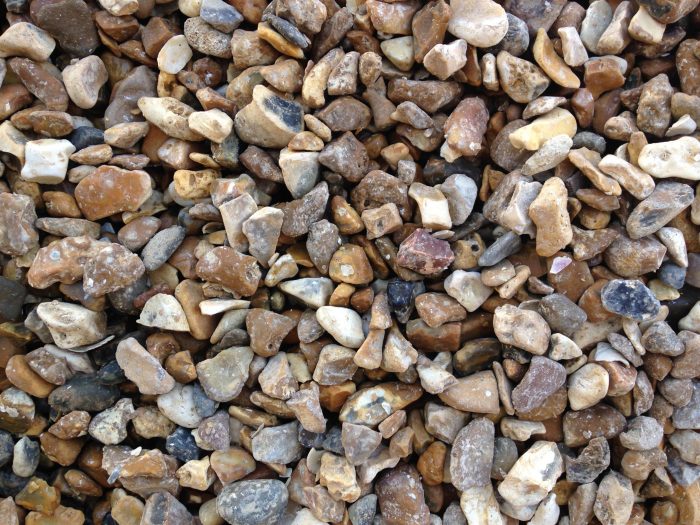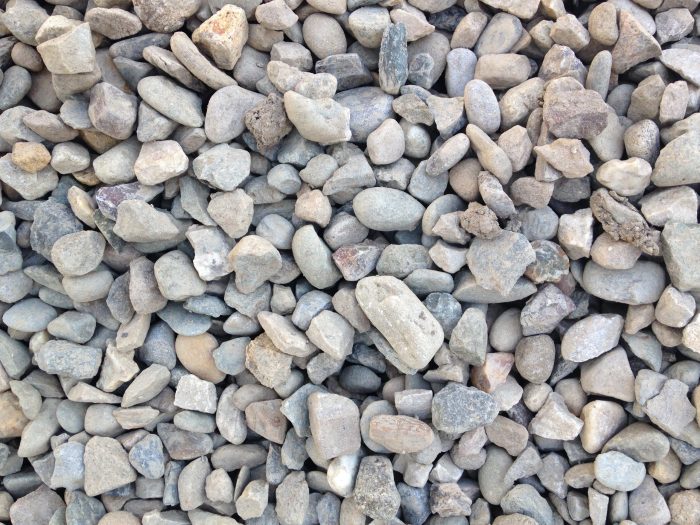Decorative gravel transforms landscapes and interiors, adding texture, color, and visual interest. From driveway enhancements to artistic garden designs, its versatility is undeniable. This comprehensive guide explores the diverse types of decorative gravel available, their applications, costs, maintenance, and environmental impact, empowering you to make informed choices for your next project.
We’ll delve into the specifics of various gravel types, comparing their durability, maintenance needs, and aesthetic qualities. Learn how to select the perfect gravel for your project, considering factors like color, texture, size, and overall design goals. We’ll also cover practical aspects like sourcing, installation, and cost-effective solutions to help you achieve your vision.
Applications of Decorative Gravel

Decorative gravel offers a versatile and aesthetically pleasing solution for a wide range of applications, extending beyond its traditional use in landscaping. Its durability, low maintenance requirements, and diverse color and texture options make it a popular choice for both residential and commercial projects. This section will explore various applications, highlighting specific gravel types and installation techniques.
Landscaping Scenarios Featuring Decorative Gravel
Three distinct landscaping scenarios showcase the diverse applications of decorative gravel. Each scenario utilizes a different gravel type, chosen to complement the overall design and functionality.
Scenario 1: A Zen Garden. This tranquil space features a meticulously raked bed of fine, white gravel, such as polished river rock. The uniformity of the gravel contributes to the serene atmosphere, and its light color reflects light, brightening the area. The smooth texture enhances the tactile experience of the garden. This design emphasizes simplicity and minimalism, making the gravel the central focus.
Scenario 2: A Mediterranean-Style Courtyard. This vibrant space incorporates larger, warm-toned gravel, like terracotta-colored pebbles, interspersed with drought-tolerant plants. The gravel’s earthy tones complement the Mediterranean aesthetic, and its porous nature allows for good drainage, crucial in hot, dry climates. The larger size of the gravel provides a more robust and textural ground cover compared to finer gravels.
Scenario 3: A Modernist Rock Garden. This contemporary landscape uses a mix of angular, dark-colored gravels, such as black basalt or slate chips, combined with drought-resistant succulents and architectural plants. The sharp edges of the gravel create visual interest, and the dark color provides a striking contrast to the greenery. This design emphasizes bold lines and textures, creating a visually impactful space.
Gravel Applications in Walkways, Driveways, and Patios, Decorative Gravel
Decorative gravel provides a practical and visually appealing alternative to traditional paving materials in walkways, driveways, and patios. Proper preparation and installation are key to ensuring longevity and preventing issues like weed growth and erosion.
Walkways: A layer of compacted base material, such as crushed stone, is essential for creating a stable foundation. This base is then covered with a layer of decorative gravel, typically 2-4 inches deep. Edging materials, such as landscape timbers or pavers, help to contain the gravel and define the walkway’s boundaries. Smaller gravel sizes, like pea gravel, are generally preferred for walkways to ensure comfortable walking.
Driveways: Driveways require a more robust base, often consisting of several layers of compacted crushed stone. Larger gravel sizes, such as river rock or crushed granite, are suitable for driveways to withstand heavier vehicle traffic. A thicker layer of gravel (4-6 inches) is necessary for durability. Proper drainage is critical to prevent water accumulation and damage.
Patios: Patios can utilize a variety of gravel types and sizes, depending on the desired aesthetic. A well-compacted base is crucial for preventing settling. Larger gravels can create a more rustic look, while smaller gravels offer a smoother surface. Edging is recommended to maintain the patio’s shape and prevent gravel from spreading.
Non-Landscaping Uses of Decorative Gravel
Beyond landscaping, decorative gravel finds applications in several other areas, offering unique benefits in each context.
Five examples of non-landscaping uses for decorative gravel are:
- Aquariums: Smooth, rounded gravel provides a natural substrate for aquarium plants and fish, while also aiding in filtration.
- Drainage Solutions: Gravel’s high porosity makes it ideal for improving drainage around foundations and septic systems, preventing waterlogging.
- Decorative Containers: Gravel can be used as a decorative filler in pots and planters, improving drainage and adding visual interest.
- Arts and Crafts: Various colored gravels are used in mosaics, terrariums, and other artistic projects.
- Weighting Agents: Gravel can be used as ballast in sandbags or to add weight to various objects.
Cost and Sourcing of Decorative Gravel

The cost of a decorative gravel project can vary significantly depending on several factors. Understanding these factors, along with the process of sourcing the gravel itself, is crucial for successful project planning and budgeting. This section will detail the price ranges for different gravel types, discuss cost-influencing factors, and Artikel the sourcing process.
Price Comparison of Decorative Gravel
The price of decorative gravel is influenced by factors such as type, color, size, source, and quantity ordered. Prices are typically quoted per cubic yard. The following table provides a sample price comparison, acknowledging that prices can fluctuate based on location and supplier. These are approximate costs and should be verified with local suppliers.
| Gravel Type | Supplier A (Price/Cubic Yard) | Supplier B (Price/Cubic Yard) | Supplier C (Price/Cubic Yard) |
|---|---|---|---|
| Pea Gravel (White) | $35-$45 | $40-$50 | $30-$40 |
| River Rock (Mixed Colors) | $50-$70 | $60-$80 | $45-$65 |
| Crushed Granite (Gray) | $40-$60 | $50-$75 | $35-$55 |
| Lava Rock (Black) | $60-$80 | $70-$90 | $55-$75 |
Factors Influencing Overall Project Cost
Beyond the cost of the gravel itself, several other factors significantly impact the total expense of a decorative gravel project. These include labor costs, delivery charges, and site preparation.Labor costs can vary depending on the project’s complexity and the hourly rate of hired labor or the time commitment if undertaking the project yourself. A large-scale project requiring significant excavation, leveling, and installation will naturally be more expensive than a smaller, simpler project.
Delivery fees are often calculated based on distance from the supplier to the project site and the volume of gravel ordered. Remote locations or large orders will generally incur higher delivery costs. Site preparation, which may include removing existing landscaping, leveling the ground, and installing edging, is another critical cost component. The extent of preparation needed will vary greatly depending on the existing site conditions.
Sourcing Decorative Gravel
Sourcing decorative gravel involves several steps. First, identify potential suppliers in your area. This can be done through online searches, referrals from landscape professionals, or by visiting local landscaping supply yards. Once you have a list of potential suppliers, contact them to obtain price quotes, inquire about availability of desired gravel types and colors, and discuss delivery options.
Compare quotes from different suppliers to ensure you are getting a competitive price. Next, clarify delivery details, including scheduling and any associated fees. Finally, confirm the total cost, including gravel, delivery, and any applicable taxes. A detailed contract or purchase order should be established to avoid misunderstandings.
Maintenance and Longevity

Decorative gravel, while offering a low-maintenance landscaping solution, still requires periodic attention to maintain its aesthetic appeal and extend its lifespan. Proper maintenance prevents weed growth, ensures proper drainage, and helps the gravel retain its vibrant color and texture. Neglecting maintenance can lead to a less attractive landscape and a shorter lifespan for the gravel itself.Proper maintenance practices significantly impact the longevity of your decorative gravel.
Regular upkeep prevents weed encroachment, maintains drainage, and preserves the overall visual appeal. Different gravel types exhibit varying degrees of durability, influenced by factors like size, shape, and material composition. Understanding these factors allows for informed decisions about gravel selection and maintenance strategies.
Gravel Pathway and Landscaping Feature Maintenance Practices
Regular sweeping or blowing away leaves, debris, and other organic matter is crucial to preventing weed growth and maintaining a clean appearance. This should be performed at least once a month, or more frequently during periods of heavy leaf fall or other debris accumulation. For larger areas, a leaf blower proves efficient, while a stiff-bristled broom is suitable for smaller spaces.
In addition to debris removal, occasional raking can help redistribute the gravel and prevent settling, ensuring a consistent surface level. This is particularly important for pathways to maintain even walking surfaces and prevent tripping hazards. Annual replenishment, discussed in the next section, further enhances longevity.
Refreshing and Replenishing Decorative Gravel
The process of refreshing and replenishing decorative gravel involves several key steps. First, a thorough cleaning is necessary to remove accumulated debris, weeds, and any dead plant material. This can be accomplished using a garden rake or blower. Next, identify areas where gravel has settled or become compacted. These areas often appear lower than the surrounding gravel.
Use a garden rake to loosen the compacted gravel and redistribute it evenly. Assess the quantity of gravel needed for replenishment. This depends on the size of the area and the degree of loss. Then, add new gravel to the identified areas, ensuring an even distribution and blending it seamlessly with the existing gravel. Finally, gently rake the entire area to create a uniform and aesthetically pleasing finish.
This process helps maintain the overall appearance and functionality of your gravel features.
Long-Term Lifespan of Various Gravel Types and Influencing Factors
The lifespan of decorative gravel varies significantly depending on the type of gravel used and the environmental conditions. For example, durable materials like granite or quartzite gravel can last for decades with minimal maintenance, while softer stones like limestone might require more frequent replenishment. Exposure to harsh weather conditions, such as extreme temperature fluctuations and heavy rainfall, can also affect the longevity of gravel.
Gravel placed in high-traffic areas, such as pathways, will naturally degrade faster than gravel in less-used areas. Proper installation, including adequate base preparation, also plays a crucial role in extending the gravel’s lifespan. For instance, a well-prepared base helps prevent settling and ensures proper drainage, reducing the risk of erosion and weed growth. Regular maintenance, as Artikeld above, is essential to maximize the lifespan of any type of decorative gravel.
Environmental Impact and Sustainability

Decorative gravel, while aesthetically pleasing, carries environmental implications throughout its lifecycle, from extraction to disposal. Understanding these impacts and exploring sustainable alternatives is crucial for responsible landscaping and construction practices. This section examines the environmental footprint of decorative gravel and highlights sustainable sourcing and recycling options to minimize its negative effects.The environmental impact of decorative gravel is multifaceted and spans several stages.
Extraction often involves significant land disturbance, potentially leading to habitat loss and soil erosion. The transportation of gravel over considerable distances contributes to greenhouse gas emissions, further exacerbating climate change. Finally, disposal of gravel, particularly when mixed with other materials, can present challenges for waste management systems.
Gravel Extraction and Transportation Impacts
Gravel extraction, a resource-intensive process, necessitates large-scale mining operations. These operations can lead to habitat fragmentation, impacting biodiversity and disrupting natural ecosystems. The removal of topsoil and vegetation exposes the underlying land to erosion, potentially leading to sedimentation in nearby waterways. Furthermore, the transportation of extracted gravel from quarries to distribution centers and ultimately to construction sites or landscaping projects contributes significantly to carbon emissions, largely due to the heavy-duty vehicles involved in the process.
For example, transporting gravel across a 100-mile distance can generate a substantial carbon footprint, depending on the volume and the mode of transportation used.
Sustainable Sourcing Practices
Sustainable sourcing of decorative gravel focuses on minimizing the environmental impact at every stage of its lifecycle. This includes employing methods that reduce habitat destruction, optimize transportation routes, and prioritize the use of locally sourced materials. Locating quarries closer to construction or landscaping sites significantly reduces transportation distances and associated emissions. Careful site selection and rehabilitation practices, such as restoring mined land to its original state or repurposing it for other beneficial uses, are also crucial aspects of sustainable sourcing.
Furthermore, supporting quarries with robust environmental management systems, including regular environmental impact assessments and compliance with environmental regulations, is essential.
Recycled Materials as a Sustainable Alternative
Recycled materials offer a compelling sustainable alternative to traditional decorative gravel. Crushed glass, recycled concrete, and even certain types of industrial waste can be processed and used as attractive and durable alternatives. Using recycled materials diverts waste from landfills, reduces the demand for virgin materials, and lowers the overall environmental footprint associated with decorative gravel. For instance, recycled glass aggregates offer a vibrant, colorful option while simultaneously addressing the problem of glass waste accumulation.
The use of recycled concrete, commonly referred to as recycled aggregate concrete (RAC), presents a sustainable choice that repurposes construction and demolition waste. This approach not only conserves natural resources but also contributes to a circular economy model.
Ultimately, choosing the right decorative gravel hinges on understanding its diverse properties and applications. By considering factors like aesthetic appeal, durability, maintenance requirements, and environmental impact, you can create stunning and sustainable landscapes or interior spaces. This guide has equipped you with the knowledge to confidently navigate the world of decorative gravel and transform your project into a masterpiece.